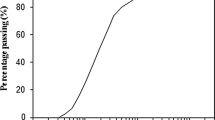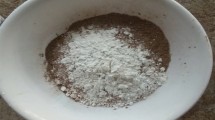Abstract
Paddy soils are typically cohesive deposits that undergo deformation with changes in their moisture content. The enhancement of the geotechnical characteristics of paddy soils is essential as more and more land was utilised for urban or industrial development. This study investigates the influence of nano-silica addition on the physical properties and strength characteristics of paddy clay. Laboratory tests were performed with varying concentrations of nano-silica (0.5%, 1%, 1.5%, and 2%) to determine the plasticity, compaction, compressive strength, and shear strength parameters of treated paddy clay. The incorporation of 1.5% nano-silica caused a remarkable and progressive increment in strength and stiffness. The UU triaxial test results revealed that the cohesive strength of nano-silica treated paddy clay was increased by 67% compared to the untreated soil after a curing period of 28 days. In addition, XRD, SEM, and FTIR tests were conducted to elucidate the microstructural mechanism of nano-silica particles on the treated paddy clay.









Similar content being viewed by others
Data Availability
The authors confirm that the data supporting the findings of this study are available within the article.
References
Rendana M, Idris WMR, Rahim SA, Rahman ZA, Lihan T (2021) Characterization of physical, chemical and microstructure properties in the soft clay soil of the paddy field area. Soc Psychol Soc 12(2):81–88. https://doi.org/10.20961/STJSSA.V18I1.50489
Jones CW (1958) Stabilization of expansive clay with hydrated lime and with Portland cement. Highw Res Board Bull 193(2):40–47
Kolias S, Kasselouri-Rigopoulou V, Karahalios A (2005) Stabilisation of clayey soils with high calcium fly ash and cement. Cem Concr Compos 27(2):301–313. https://doi.org/10.1016/j.cemconcomp.2004.02.019
Anagnostopoulos CA (2015) Strength properties of an epoxy resin and cement-stabilized silty clay soil. Appl Clay Sci 114:517–529. https://doi.org/10.1016/j.clay.2015.07.007
Chen J-J, Zhang L, Zhang J-F, Zhu Y-F, Wang J-H (2013) Field tests, modification, and application of deep soil mixing method in soft clay. J Geotech Geoenviron Eng 139(1):24–34. https://doi.org/10.1061/(asce)gt.1943-5606.0000746
Ambily AP, Gandhi SR (2007) Behavior of stone columns based on experimental and FEM analysis. J Geotech Geoenviron Eng 133(4):405–415. https://doi.org/10.1061/(asce)1090-0241(2007)133:4(405)
Changizi F, Haddad A (2017) Improving the geotechnical properties of soft clay with nano-silica particles. Proc Inst Civ Eng Ground Improv 170(2):62–71. https://doi.org/10.1680/jgrim.15.00026
Wong C, Pedrotti M, El Mountassir G, Lunn RJ (2018) A study on the mechanical interaction between soil and colloidal silica gel for ground improvement. Eng Geol 243:84–100. https://doi.org/10.1016/J.ENGGEO.2018.06.011
Ahmadi H, Shafiee O (2019) Experimental comparative study on the performance of nano-SiO2 and microsilica in stabilization of clay. Eur Phys J Plus 134(9):1–14. https://doi.org/10.1140/epjp/i2019-12918-1
Fattahi Masrour F, Naghdipour Mirsadeghi M, MolaAbasi H, Jamshidi Chenari R (2021) Effect of nanosilica on the macro- and microbehavior of dispersive clays. J Mater Civ Eng 33(12):04021349. https://doi.org/10.1061/(asce)mt.1943-5533.0003975
Kalhor A, Ghazavi M, Roustaei M (2022) Impacts of nano-silica on physical properties and shear strength of clayey soil. Arab J Sci Eng 47(4):5271–5279. https://doi.org/10.1007/s13369-021-06453-2
Choobbasti AJ, Vafaei A, Soleimani Kutanaei S (2018) Static and cyclic triaxial behavior of cemented sand with nanosilica. J Mater Civ Eng 30(10):04018269. https://doi.org/10.1061/(asce)mt.1943-5533.0002464
Thomas G, Rangaswamy K (2020) Strengthening of cement blended soft clay with nano-silica particles. Geomech Eng 20(6):505–516. https://doi.org/10.12989/gae.2020.20.6.505
Kulkarni PP, Mandal JN (2022) Strength evaluation of soil stabilized with nano silica-cement mixes as road construction material. Constr Build Mater 314(PB):125363. https://doi.org/10.1016/j.conbuildmat.2021.125363
Ghorbani A et al (2019) Effect of selected nanospheres on the mechanical strength of lime-stabilized high-plasticity clay soils. Adv Civ Eng. https://doi.org/10.1155/2019/4257530
Tomar A, Sharma T, Singh S (2019) Strength properties and durability of clay soil treated with mixture of nano silica and polypropylene fiber. Mater Today Proc 26:3449–3457. https://doi.org/10.1016/j.matpr.2019.12.239
Kulanthaivel P, Selvakumar S, Soundara B, Kayalvizhi VS, Bhuvaneshwari S (2022) Combined effect of nano-silica and randomly distributed fibers on the strength behavior of clay soil. Nanotechnol Environ Eng. https://doi.org/10.1007/s41204-021-00176-3
Thomas S, Chandrakaran S, Sankar N (2023) Effect of nano-calcium carbonate on the geotechnical and microstructural characteristics of highly plastic paddy clay. Arab J Sci Eng. https://doi.org/10.1007/s13369-023-07679-y
Choobbasti AJ, Kutanaei SS (2017) Microstructure characteristics of cement-stabilized sandy soil using nanosilica. J Rock Mech Geotech Eng 9(5):981–988. https://doi.org/10.1016/j.jrmge.2017.03.015
Kalhor A, Ghazavi M, Roustaei M, Mirhosseini SM (2019) Influence of nano-SiO2 on geotechnical properties of fine soils subjected to freeze-thaw cycles. Cold Reg Sci Technol 161(February):129–136. https://doi.org/10.1016/j.coldregions.2019.03.011
Ding P, Pacek AW (2008) De-agglomeration of silica nanoparticles in the presence of surfactants. J Dispers Sci Technol 29(4):593–599. https://doi.org/10.1080/01932690701729302
Park S, Choi GR, Kim JH, Lee JC, Kim SJ (2012) Dispersion effect of sodium hexametaphosphate on the photocatalytic efficiency of a solution-combusted ZnO nanopowder. J Korean Phys Soc 61(9):1400–1403. https://doi.org/10.3938/jkps.61.1400
Mitchell JK, Soga K (1994) Fundamentals of soil behavior. Soil Sci. https://doi.org/10.1097/00010694-199407000-00009
Suganya K, Sivapullaiah PV (2017) Role of composition and fabric of Kuttanad clay: a geotechnical perspective. Bull Eng Geol Environ 76(1):371–381. https://doi.org/10.1007/s10064-016-0911-5
Sridharan A, Prakash K (1998) Mechanism controlling the shrinkage limit of soils. Geotech Test J 21(3):240–250. https://doi.org/10.1520/gtj10897j
Mir BA, Reddy SH (2021) Mechanical behaviour of nano-material (Al2O3) stabilized soft soil. Int J Eng Trans C Asp 34(3):636–643. https://doi.org/10.5829/ije.2021.34.03c.07
Smitha S, Rangaswamy K, Keerthi DS (2021) Triaxial test behaviour of silty sands treated with agar biopolymer. Int J Geotech Eng 15(4):484–495. https://doi.org/10.1080/19386362.2019.1679441
Obada DO et al (2016) Effect of mechanical activation on mullite formation in an alumina-silica ceramics system at lower temperature. World J Eng 13(4):288–293. https://doi.org/10.1108/WJE-08-2016-039
X Diffraction (1981) Standard X-ray diffraction powder patterns section 18, no. 18.
Walker CS, Savage D, Tyrer M, Ragnarsdottir KV (2007) Non-ideal solid solution aqueous solution modeling of synthetic calcium silicate hydrate. Cem Concr Res 37(4):502–511. https://doi.org/10.1016/j.cemconres.2006.12.002
Rathod V, Anupama AV, Kumar RV, Jali VM, Sahoo B (2017) Correlated vibrations of the tetrahedral and octahedral complexes and splitting of the absorption bands in FTIR spectra of Li–Zn ferrites. Vib Spectrosc 92:267–272. https://doi.org/10.1016/j.vibspec.2017.08.008
Wu B, Ye G (2016) Carbonation mechanism of different kind of C–S–H: rate and products. Concr Suppl Cem Mater (August), p. 455. https://biblio.ugent.be/publication/8531148
Darmakkolla SR, Tran H, Gupta A, Rananavare SB (2016) A method to derivatize surface silanol groups to Si-alkyl groups in carbon-doped silicon oxides. RSC Adv 6(95):93219–93230. https://doi.org/10.1039/c6ra20355h
Stuart BH (2005) Infrared spectroscopy: fundamentals and applications. Wiley, New York. https://doi.org/10.1002/0470011149
Naseri F, Irani M, Dehkhodarajabi M (2016) Effect of graphene oxide nanosheets on the geotechnical properties of cemented silty soil. Arch Civ Mech Eng 16(4):695–701. https://doi.org/10.1016/j.acme.2016.04.008
Sulpizi M, Gaigeot MP, Sprik M (2012) The silica-water interface: how the silanols determine the surface acidity and modulate the water properties. J Chem Theory Comput 8(3):1037–1047. https://doi.org/10.1021/ct2007154
Zhou M, Zhang L, Lu H, Shao L, Chen M (2002) Reaction of silicon dioxide with water: a matrix isolation infrared and density functional theoretical study. J Mol Struct 605(2–3):249–254. https://doi.org/10.1016/S0022-2860(01)00767-0
Neeru J, Shaliesh C, Vaishali T, Purav S, Manoherlal R (2019) Role of orthosilicic acid (OSA) based formulation in improving plant growth and development. SILICON 11(5):2407–2411. https://doi.org/10.1007/s12633-015-9380-x
Strohmeier L, Schrittesser B, Schlögl S (2022) Approaches toward in situ reinforcement of organic rubbers: strategy and recent progress. Polym Rev 62(1):142–174. https://doi.org/10.1080/15583724.2021.1897998
Abhilash PP, Nayak DK, Sangoju B, Kumar R, Kumar V (2021) Effect of nano-silica in concrete; a review. Constr Build Mater 278:122347. https://doi.org/10.1016/j.conbuildmat.2021.122347
Acknowledgements
The authors thank to Sophisticated Test and Instrumentation Center, Cusat, Cochin for SEM images.
Funding
This research did not receive any specific grant from funding agencies in the public, commercial, or private sectors.
Author information
Authors and Affiliations
Contributions
ST provided experimental investigation and original—draft preparation. SC conducted conceptualisation and supervision. NS performed methodology and visualisation.
Corresponding author
Ethics declarations
Conflict of interest
The authors have no conflicts of interest to declare that are relevant to the content of this article.
Ethical Approval
The paper reflects the authors' own research and analysis in a truthful and complete manner.
Additional information
Publisher's Note
Springer Nature remains neutral with regard to jurisdictional claims in published maps and institutional affiliations.
Rights and permissions
Springer Nature or its licensor (e.g. a society or other partner) holds exclusive rights to this article under a publishing agreement with the author(s) or other rightsholder(s); author self-archiving of the accepted manuscript version of this article is solely governed by the terms of such publishing agreement and applicable law.
About this article
Cite this article
Thomas, S., Chandrakaran, S. & Sankar, N. Role of Nano-silica Additive on the Strength Behaviour of a Highly Plastic Clay Found in an Indian Paddy Field. Indian Geotech J (2024). https://doi.org/10.1007/s40098-024-00945-2
Received:
Accepted:
Published:
DOI: https://doi.org/10.1007/s40098-024-00945-2




